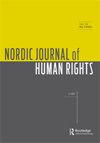非物质文化遗产和知识产权保护是同一人权硬币的两面:爱沙尼亚的记忆景观和传统造船
IF 1.2
Q3 POLITICAL SCIENCE
引用次数: 0
摘要
摘要本文关注文化遗产保护背景下非物质遗产与知识产权作为人权的互动关系。权利是任何监管模式的核心;在许多人权公约中,非物质文化遗产和知识产权都被定义为人权。在这里,我们将探讨如何将非物质文化遗产纳入国家法律秩序,并利用知识产权支持非物质文化遗产保护的目标。我们的分析基于爱沙尼亚非物质遗产保护的两个案例研究:一个是强调民间传说背景下的集体和个人知识产权的Lahemaa Memoryscapes项目,另一个是涉及传统知识、版权和工业产权问题的爱沙尼亚传统木船制造项目。这两个案例揭示了非物质遗产和遗产社区作为权利持有人的难以捉摸的特征。我们还使用了其他爱沙尼亚遗产项目的例子,说明为什么知识产权和非物质文化遗产机制能够使遗产社区实现其人权,并建立知识产权能力,特别关注非物质文化遗产保护。我们将人权概念化为改善日常生活的实用工具,而不是理论概念。本文章由计算机程序翻译,如有差异,请以英文原文为准。
Intangible Cultural Heritage and Intellectual Property Protection as Two Sides of the Same Human Rights Coin: Memoryscapes and Traditional Boatbuilding in Estonia
ABSTRACT This article focuses on the interaction between intangible heritage (ICH) and intellectual property (IP) as human rights in the context of cultural heritage protection. Rights constitute a core of any regulatory model; ICH and IP are each defined as human rights in numerous human rights conventions. Here, we explore how to integrate ICH into national legal orders and use IP to support the objectives of ICH protection. Our analysis relies on two case studies of the protection of intangible heritage in Estonia: the Lahemaa Memoryscapes project, which highlights collective and individual IP rights in the context of folklore, and traditional wooden boatbuilding in Estonia, which involves traditional knowledge, copyright, and industrial property rights problems. These two case studies reveal the elusive character of intangible heritage and heritage communities as rightsholders. We also use examples of other Estonian heritage projects, showing why IP and ICH mechanisms enable heritage communities to implement their human rights and build IP competencies with a special focus on ICH protection. We conceptualise human rights as practical tools to improve everyday life rather than as theoretical concepts.
求助全文
通过发布文献求助,成功后即可免费获取论文全文。
去求助
来源期刊

Nordic Journal of Human Rights
POLITICAL SCIENCE-
CiteScore
1.00
自引率
25.00%
发文量
29
期刊介绍:
The Nordic Journal of Human Rights is the Nordic countries’ leading forum for analyses, debate and information about human rights. The Journal’s aim is to provide a cutting-edge forum for international academic critique and analysis in the field of human rights. The Journal takes a broad view of human rights, and wishes to publish high quality and cross-disciplinary analyses and comments on the past, current and future status of human rights for profound collective reflection. It was first issued in 1982 and is published by the Norwegian Centre for Human Rights at the University of Oslo in collaboration with Nordic research centres for human rights.
 求助内容:
求助内容: 应助结果提醒方式:
应助结果提醒方式:


